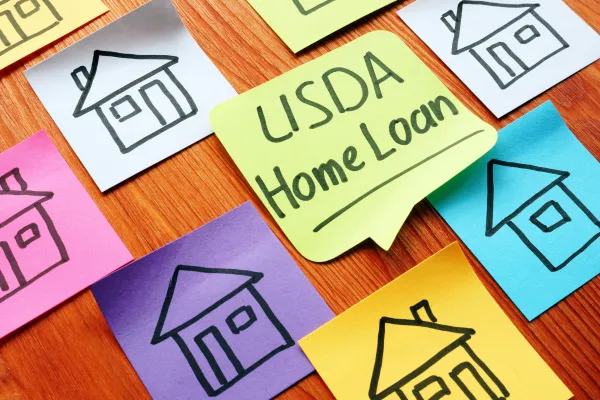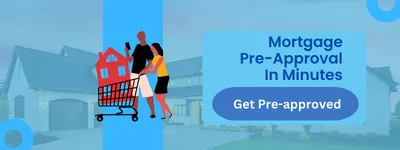
Fact Checked
What Is A USDA Loan?
Our guidance draws upon our extensive expertise within the mortgage industry, and our unwavering commitment lies in assisting you in realizing your dream of homeownership.
A USDA loan, often referred to as a 100% mortgage, is designed to assist buyers seeking homes in non-urban regions of the United States. One notable advantage of USDA mortgage rates is their government-backed nature, offering borrowers access to lower interest rates and more affordable monthly payments in comparison to other government-backed programs such as FHA loans and VA loans.
USDA, an acronym for the United States Department of Agriculture, is primarily recognized for its involvement in agriculture, forestry, and food-related initiatives. However, it also plays a significant role in promoting home affordability and fostering robust communities in rural and suburban areas.
The expansive reach of the USDA's influence is evident through its eligibility map, which reveals that a remarkable 91 percent of the United States falls within the USDA boundary. If you're contemplating a home purchase outside of urban areas, considering the USDA's home loan program is a wise choice, particularly for first-time homebuyers.
In this comprehensive article, we aim to provide first-time homebuyers with all the essential information they need to navigate the world of USDA loans effectively.
A Brief History of USDA Loans
FHA loans are characterized by three key features:
The USDA mortgage program, officially known as the USDA Rural Development Guaranteed Housing Loan Program, traces its roots back to 1949, emerging in the aftermath of World War II as an integral component of the American Housing Act.
Drawing inspiration from two prior housing programs – the FHA loan and the VA loan – the government recognized the profound impact of homeownership. It became evident that homeownership plays a pivotal role in nurturing and fortifying communities, fostering employment opportunities for Americans, and contributing substantially to state and local tax revenues.
The core objective of the USDA housing program is to facilitate accessible and affordable homeownership in non-urban regions, catering specifically to individuals with low to moderate incomes. This program distinguishes itself by offering interest rates below the prevailing market rates, eliminating the need for a down payment, and sparing buyers from the burden of mortgage insurance payments to lenders.
Fast forward to the present day, the USDA continues to play a crucial role in facilitating homeownership by supporting a vast portfolio of home loans, amounting to hundreds of billions of dollars.
How Does a USDA Loan Work?
The USDA mortgage program, officially known as the USDA Rural Development Guaranteed Housing Loan Program, traces its roots back to 1949, emerging in the aftermath of World War II as an integral component of the American Housing Act.
Drawing inspiration from two prior housing programs – the FHA loan and the VA loan – the government recognized the profound impact of homeownership. It became evident that homeownership plays a pivotal role in nurturing and fortifying communities, fostering employment opportunities for Americans, and contributing substantially to state and local tax revenues.
The core objective of the USDA housing program is to facilitate accessible and affordable homeownership in non-urban regions, catering specifically to individuals with low to moderate incomes. This program distinguishes itself by offering interest rates below the prevailing market rates, eliminating the need for a down payment, and sparing buyers from the burden of mortgage insurance payments to lenders.
Fast forward to the present day, the USDA continues to play a crucial role in facilitating homeownership by supporting a vast portfolio of home loans, amounting to hundreds of billions of dollars.
See today’s mortgage rates.
How Does The USDA Define Rural?
The USDA relies on the definition of "rural" outlined in Section 502 of the Housing Act of 1949. This definition stipulates that a community qualifies as rural if it meets these criteria:
A community with fewer than 2,500 residents that is not closely connected to a major city.
A community characterized as "rural in character" with a population of less than 10,000 residents.
A community with fewer than 20,000 residents that is not part of a metropolitan statistical area.
It's important to note that communities not meeting these criteria are classified as "urban." Interestingly, there is no official government definition for suburbs or exurbs. In the eyes of the government, all homes in the United States fall into either the rural or urban category.
In 2020, the Census Bureau introduced additional criteria for census tracts to distinguish between rural and urban areas. A census tract is considered rural if it satisfies the following conditions:
It has fewer than 2,000 housing units or a population of less than 5,000 people.
It has fewer than 500 residents per square mile.
It contains no more than 425 housing units per square mile.
It is situated beyond a half-mile radius from an airport with 2,500 passengers or more per year.
Homes located in rural communities or rural census tracts are eligible for USDA mortgages, providing valuable opportunities for potential homebuyers.
Search On A USDA Eligibility Map
Navigating the government's USDA Eligibility Website can often prove to be a daunting task – why not take a look for yourself?
To simplify the process of determining USDA mortgage eligibility, LoveYourRate.com has developed an effortlessly user-friendly USDA mortgage eligibility map, available to all at no cost.
The USDA Eligibility Map offers immediate USDA eligibility status for every household in the United States, down to the level of USPS addresses. This map undergoes regular updates to ensure it accurately reflects any alterations made by the U.S. Department of Agriculture and updates from Census Bureau data.
Make sure you check the eligibility status of your prospective home by utilizing the convenient USDA lookup map.
How Do You Qualify for a USDA Loan?
To qualify for a USDA loan, prospective homebuyers are required to meet the Department of Agriculture's specific geographic and income eligibility criteria, in addition to meeting other essential mortgage qualifications.
Eligible homebuyers must satisfy the following conditions:
1. Property Location: Purchase a property situated within a rural census tract.
2. Income: Maintain a low or moderate household income level, as defined by USDA guidelines.
3. Payment History: Demonstrate a consistent history of on-time bill payments.
4. Residency Status: Be a U.S. citizen or permanent resident alien.
5. Homeownership Education: Successfully complete a certified homeownership education course, which can be done either online or through in-person sessions.
The USDA enforces specific income limits for its potential homebuyers, and these limits can be found on the USDA website. For more detailed information, it's advisable to consult your mortgage lender or feel free to reach out to us through our chat service.
Furthermore, it's important to note that USDA mortgages are exclusively intended for the purchase of modest primary residences. They are not applicable for vacation homes, rental properties, or commercial purposes such as housing a business or retail store.
USDA mortgages are offered solely as 30-year fixed-rate mortgages, with no provision for adjustable-rate options.
USDA mortgages don’t require mortgage insurance
The USDA doesn’t require a 20 percent down payment and won’t charge mortgage insurance, which can add an effective one percent or more to your annual interest rate. Instead, the USDA charges a one-time, 1% guarantee fee at closing and an additional 0.35 percent per year.
Buyers can buy a USDA home with $0 out of pocket
Home buyers who use USDA-backed mortgages can purchase a home with no money out of pocket whatsoever. USDA guidelines allow buyers to add their guarantee fee, closing costs, and loan fees to their loan amount, even above 100% of the home’s purchase price. The USDA also permits seller concessions to minimize the cash required to close.
USDA mortgages are assumable
USDA mortgages include an assumption clause, which means that a future buyer of your home can buy your home and your mortgage simultaneously, with the same interest rate and loan terms. Assumable mortgages can raise a home’s resale value when interest rates rise because the home’s payment is locked to yesterday’s mortgage rates.
Buyers can access the USDA Streamline Refinance program
The USDA Streamline Refinance is an automated mortgage rate reduction program for homeowners with existing USDA mortgages. To get approved, USDA homeowners must show they’ve paid their mortgage on time for the last 12 months; and that the refinance results in a $50 savings per month or more. There is no employment verification or home appraisal needed.
Common Questions About USDA Mortgages
Why is the USDA Mortgage Referred to as the "Rural Loan"?
USDA loans have earned the nickname "rural loans" because they primarily cater to low-density communities with a rural character, encompassing not only purely rural areas but also suburban and exurban regions.
Can I Use a USDA Loan for a Working Farm Purchase?
No, USDA loans are exclusively intended for the acquisition of residential properties and cannot be used to purchase working farms or other commercial entities.
Can I Utilize a USDA Mortgage for a Manufactured Home Purchase?
Certainly, homebuyers can employ USDA mortgages to finance the purchase of manufactured homes.
Can I Use a USDA Mortgage for Buying a Modular Home?
Absolutely, modular homes can be financed through the USDA loan program.
Can I Apply for a USDA Mortgage to Purchase a Condo?
Yes, condominiums can indeed be financed using the USDA mortgage program.
Getting a USDA Mortgage After Chapter 7 Bankruptcy in 2024
Starting in 2024, homebuyers with a Chapter 7 bankruptcy in their credit history can apply for and obtain approval for a USDA mortgage after a waiting period of 3 years following their discharge date.
Getting a USDA Mortgage After Chapter 13 Bankruptcy in 2024
Also new for 2024, homebuyers with a Chapter 13 bankruptcy in their credit history can apply for and obtain approval for a USDA mortgage after a 12-month waiting period following the conclusion of their debt restructuring plan.
What are the Credit Score Requirements for a USDA Mortgage?
The USDA suggests that homebuyers should have a satisfactory track record of bill payment. Mortgage lenders have the authority to establish their specific credit score requirements, which may range from 580, 600, 620, 640, to 660.
Can I use a Down Payment with a USDA Mortgage?
Although USDA loans allow for 100% financing without a down payment, homebuyers have the option to make a down payment.
What is the Maximum loan amount with a USDA Mortgage?
The Rural Housing Development Home Loan program sets a maximum loan size by county, known as the USDA Loan Limits. Homebuyers can secure a mortgage amount within these limits based on their household income and monthly debts.
How do I determine if I'm Eligibil for a USDA Mortgage?
All homes situated in rural communities are eligible for the USDA Section 502 mortgage. You can use the lookup map to assess eligibility for a specific property or reach out to us via chat for assistance.
Can I use a USDA Mortgage for Short-Term Rental?
USDA loans are exclusively designed for primary residences and cannot be used to convert homes into short-term rental properties, such as Airbnb or VRBO listings.
Are USDA Mortgages for First-Time and Repeat Homebuyers?
The USDA mortgage program extends its benefits to both first-time and repeat homebuyers.
How Much are Closing Costs for USDA Mortgages?
Closing costs associated with a USDA loan can vary based on the mortgage company and the state. Generally, these costs range between 1-2% of the loan size. To minimize closing costs, consider opting for a no closing cost mortgage.
What are USDA Mortgage Rates?
USDA mortgage rates are subject to daily fluctuations driven by market conditions. Due to the USDA's guarantee of these mortgages against loss, lenders often offer lower interest rates for USDA loans compared to conventional and FHA loans.
Who is Eligible for a USDA Mortgage?
USDA mortgages are accessible to homebuyers purchasing a primary residence in non-urban areas, provided their household income does not exceed the average income for the area.
How do I Apply for a USDA Mortgage?
Homebuyers can apply for a USDA Guaranteed Loan online through a mortgage company or in person at a bank's branch office. Direct Loans, tailored for very-low-income borrowers, require a direct application with the USDA.
What are the Income Limits for USDA Mortgages?
The USDA mortgage program has income limits that are contingent on the county and household size. Households with five or more members receive higher income limits compared to those with four or fewer members. You can use the USDA eligibility map to confirm your income eligibility.
What are the Property Size Requirements for USDA Mortgages?
USDA home loans mandate a minimum home size of 400 square feet for manufactured properties, but there is no maximum property size.
Can I use a USDA Mortgage for Multi-Family Properties?
USDA mortgages are exclusively for single-family residences, and they do not apply to multi-family homes. Multi-family properties require different mortgage programs, such as FHA or conventional home loans.
What is the Timeline for USDA Mortgage Approval?
Pre-approved USDA mortgages can progress to approval status in a matter of minutes. For non-pre-approved mortgages, the timeline may vary.
What is the Documentation Needed for a USDA Mortgage Application?
USDA mortgages necessitate the verification of income sources, assets, savings, credit scores, and employment history. Buyers can submit documentation digitally or as hard copies for this purpose.
To check whether the USDA mortgage is best for you, start a pre-approval with Canopy Mortgage and let a mortgage guide help you put your best foot forward.


Branch: Canopy Mortgage - TLC Group - 13809 Research Blvd, Ste 500, Austin, TX 78750 | Office #512-598-9093 | NMLSConsumerAccess.org #: 1359687 | Equal Housing Lender -All loans subject to credit and property approval.
Consumers wishing to file a complaint against a banker or a residential mortgage loan originator should complete and send a complaint form to the Texas department of savings and mortgage lending, 2601 North Lamar, suite 201, Austin, Texas 78705. Complaint forms and instructions may be obtained from the department’s website at www.sml.texas.gov. A toll-free consumer hotline is available at 1-877-276-5550. The department maintains a recovery fund to make payments of certain actual out of pocket damages sustained by borrowers caused by acts of licensed residential mortgage loan originators. A written application for reimbursement from the recovery fund must be filed with and investigated by the department prior to the payment of a claim. For more information about the recovery fund, please consult the department’s website at www.sml.texas.gov. State Licenses page, Privacy Policy, and Terms of Use


Facebook
Instagram
LinkedIn
Youtube
TikTok